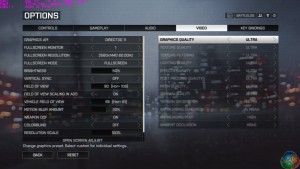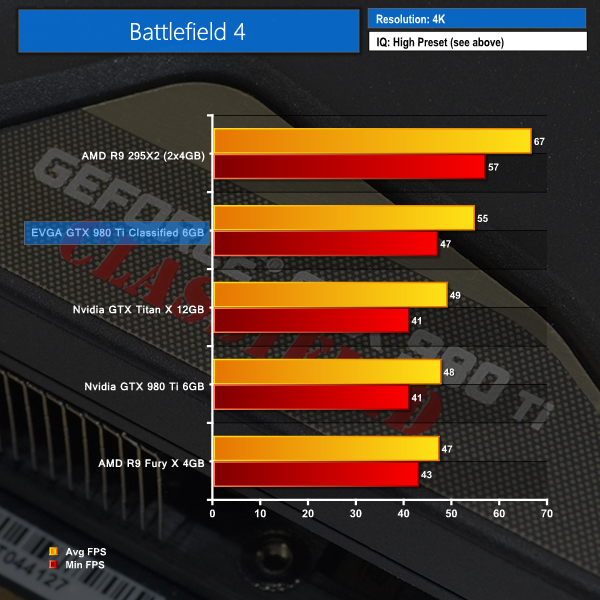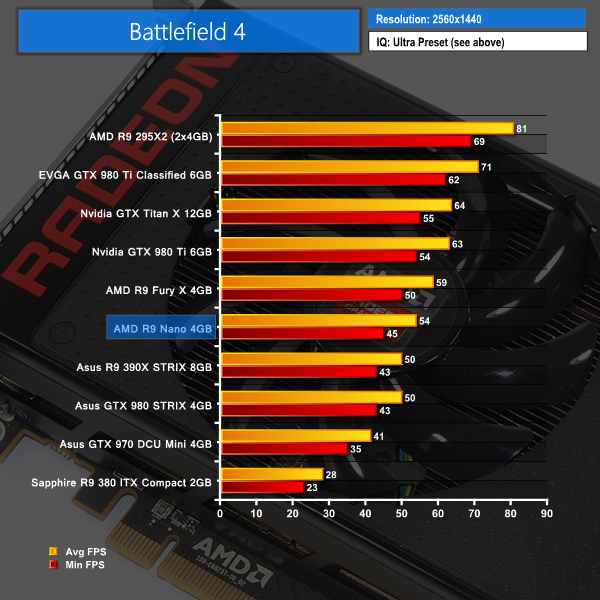Battlefield 4 ’s single-player Campaign takes place in 2020, six years after the events of its predecessor. Tensions between Russia and the United States have been running at a record high, due to a conflict between the two countries that has been running for the last six years. (Wikipedia).


For 2560×1440 testing, we opted for Battlefield 4's Ultra preset. When testing with the demanding 4K resolution, we opted for Battlefield 4's High IQ preset in order to make playable frame rates a greater possibility. Our frame rates are recorded using a section of the game.

Performance of the R9 Nano sits between that of a factory-overclocked Asus R9 390X STRIX and the reference R9 Fury X when running Battlefield 4 at 1440P. Hitting an average frame rate of 54 FPS when using the game's Ultra preset is solid performance and realistically translates into a perfectly enjoyable gameplay experience from this six-inch card. Asus' GTX 970 DCU Mini is significantly slower than the R9 Nano at 1440P, although that is to be expected given the price differential.
4K performance still places the R9 Nano between a Fury X and R9 390X, however the increased resolution allows AMD's flagship single-GPU card to widen its performance lead. Why is this given that the performance gap should be constant between the two Fiji-equipped graphics cards? It's simply a case of the higher-stress 4K resolution forcing a reduction in the average GPU core clock that the R9 Nano reaches. The 275W water-cooled Fury X has no such clock-speed constraints to contend with.
AMD's R9 Nano out-guns the Asus GTX 970 DCU Mini by 32% at 4K, making it the fastest SFF card in Battlefield 4. It's also significantly more expensive than the Nvidia-based solution and further image quality reduction would be required to achieve enjoyable frame rates even on the R9 Nano at 4K. The overclocked R9 Nano does, however, manage to sit in a comfortable range of frame rates for good usage with a 4K FreeSync screen.
 KitGuru KitGuru.net – Tech News | Hardware News | Hardware Reviews | IOS | Mobile | Gaming | Graphics Cards
KitGuru KitGuru.net – Tech News | Hardware News | Hardware Reviews | IOS | Mobile | Gaming | Graphics Cards




Price!! AMD… I know it’s unique but you had a good opportunity to fight NVIDIA but you priced yourself too high (again).
And with their yield issues it will be priced even higher at retailers lol.
Who are you kidding?
I can’t see how they can charge the same as a Fury X and the Fury X has the added cost of watercooling.
Don’t matter on price, Gaming enthusiast’s will buy it just because of the size and performance it give’s, If people are willing to spend like 1500 for a titan X, I’m sure people will pay 1/3 of the price for the nano.
Can you cram Fury x into SFF case?
^ This, it delivers very well for the size/form factor in spades. But if anyone has the space/non ITX case to house longer cards the Nano isn’t for them, people just need to realize this and move on.
yes. Read a review somewhere (Hexus?) where they mentioned you could cram a Fury X into some mITX cases 🙂
Most mITX cases are long, to incorporate a full sized GFX card, you can for example get a Strix 980 into a Fractal Node 304. It’s only when you get down to stuff like the Coolermaster Elite 110 that an mITX card becomes necessary.
For £515 you can buy a 980Ti, unless you really needed a smaller card why would you purchase this ?
Indeed. Most of the people complaining about the niche this card lives in wouldn’t be buying one anyway, they’re just more interested in complaining about it.
Most of the complaining is from nvidia fanboys, trolls or paid shills. There is no way a sane consumer can be totally blind to the value proposition this card gives in ultra SFF compared to useless value the titan X gives when it is so overpriced for any form factor.
Of course there are some legitimate voices of dissatisfaction among those who really wanted to buy this card thinking it will be a more cut down version of Fiji chip and could be had for like 400-450 USD, those people have legit reasons to be slightly miffed but given the performance this thing shows they will quickly realize this card isn’t for them, the $549 R9 Fury is.
I would buy it with no hessitation, and I’m a full tower user.